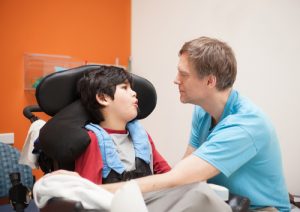 Cerebral palsy is a devastating and irreversible birth injury that affects the brain, but the name for the disease itself is an umbrella term. There are many types of CP that vary in severity and symptoms and affect children in different ways, some more significantly than others.
Cerebral palsy is a devastating and irreversible birth injury that affects the brain, but the name for the disease itself is an umbrella term. There are many types of CP that vary in severity and symptoms and affect children in different ways, some more significantly than others.
In all cases of cerebral palsy though, the diagnosis is heartbreaking, and the hopes for your child’s future are significantly altered.
Understanding the Different Forms of Cerebral Palsy
Cerebral palsy is typically a condition that occurs at birth, and is therefore considered a birth trauma. Besides pressure to the head or stroke at birth, CP can also be caused by a lack of oxygen. Poor medical care – prenatal or during delivery – can lead to this devastating diagnosis. Here are just some of the forms of cerebral palsy:
- Athetoid Cerebral Palsy: The most common form of cerebral palsy, athetoid CP is characterized by involuntary, abnormal movement. Typically, the child is intellectually capable, but the lack of control over their muscles can make them feel trapped in their own body. This palsy is also known as choreoathetoid cerebral palsy or dyskinetic cerebral palsy.
- Epidural Hematoma Cerebral Palsy: The name of this form of CP indicates how the child got cerebral palsy, most likely from a stroke at birth. This could have been caused by an infection, which could potentially have been caught and treated with the proper prenatal care. Negligence during delivery can also be a factor in this birth injury.
- Diplegic Cerebral Palsy: In diplegic cerebral palsy, the upper body is not affected at all but the lower muscle groups are. This form of CP is often characterized by legs that are crossed at the knees and make walking difficult. Muscles are tense – referred to as spastic – and continuously contracted.
- Dystonic Cerebral Palsy: The hallmark of dystonic cerebral palsy is abnormal muscle movement. Muscles may be extremely tense or floppy. Movement may be involuntarily and slow. This condition contributes to writhing movements.
- Subdural Hematoma Cerebral Palsy: There are two forms of CP that involve an intracranial hemorrhage. Along with subdural hematoma CP, there is also Grade 1 IVH CP. A Grade 1 diagnosis is a hopeful diagnosis, in that the child may have some developmental hurdles and setbacks, but their condition is mild and can usually be overcome with proper therapy. The subdural hematoma is caused by a direct head injury, often during birth, leading to a brain injury.
- Ataxic Cerebral Palsy: The rarest form of CP, ataxic cerebral palsy affects fine motor skills as well as balance and speech. In attempting to carry out a fine motor skill, like buttoning a shirt or writing, tremors may occur because the child’s muscles are strained by the effort.
These are not the only types of cerebral palsy. If your child experiences different symptoms, or if their condition is not listed, that does not mean you don’t have a viable case. All cerebral palsy diagnoses are life-altering, for the sufferer as well as their family. Knowing that this condition could have been prevented makes the reality of it even more difficult to bear. You are entitled to compensation for your suffering, medical bills, therapy fees, equipment costs, and more. Contact Thurswell Law for a free consultation with one of our experienced cerebral palsy birth injury attorneys. We do not charge any fees unless you collect. Call (248) 354-2222 today to schedule your consultation.







